Abstract
1. The effects of levodopa alone (50 mg kg-1) and levodopa (10 mg kg-1) plus benserazide (50 mg kg-1) were tested on the levels of dopa, dopamine, 3-methoxytyrosine (3-MT), 3,4-dihydroxyphenylacetic acid (DOPAC) and homovanillic acid (HVA), measured by h.p.l.c. with electrochemical detection, in samples of plasma, CSF, urine, striatum and hypothalamus of rats taken 30 min after injection. Levodopa plus benserazide produced significantly higher levels of dopa in plasma and brain than levodopa alone and reduced the peripheral synthesis and metabolism of dopamine. 2. When given chronically over 6 weeks the advantages of adding benserazide (50 mg kg-1 day-1) to levodopa (40 mg kg-1 day-1) were less marked and although more dopamine was present in the striatum than with levodopa given alone (200 mg kg-1 day-1) there was no evidence of any increase in its metabolites (HVA and DOPAC) and therefore of its turnover and utilisation. 3. The most striking effect of chronic treatment with levodopa plus benserazide was the appearance of large quantities of 3-MT in plasma, CSF and brain. 4. When levodopa alone, or levodopa plus benserazide, was given as an acute challenge to animals receiving the same treatment chronically, it was found that levodopa alone still produced increases in striatal dopamine, DOPAC and HVA in those animals dosed chronically on levodopa, but it was less effective in this respect when given with benserazide to the animals dosed with levodopa plus benserazide.(ABSTRACT TRUNCATED AT 250 WORDS)
Full text
PDF
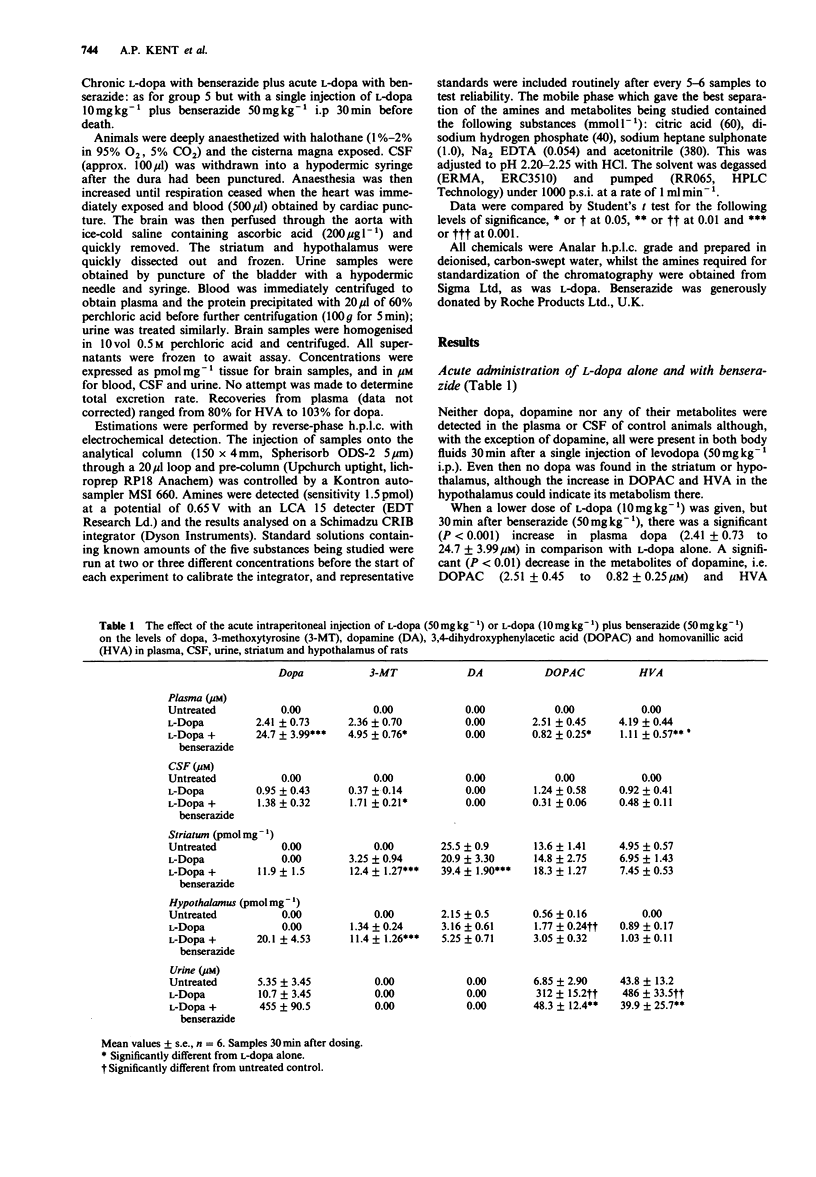
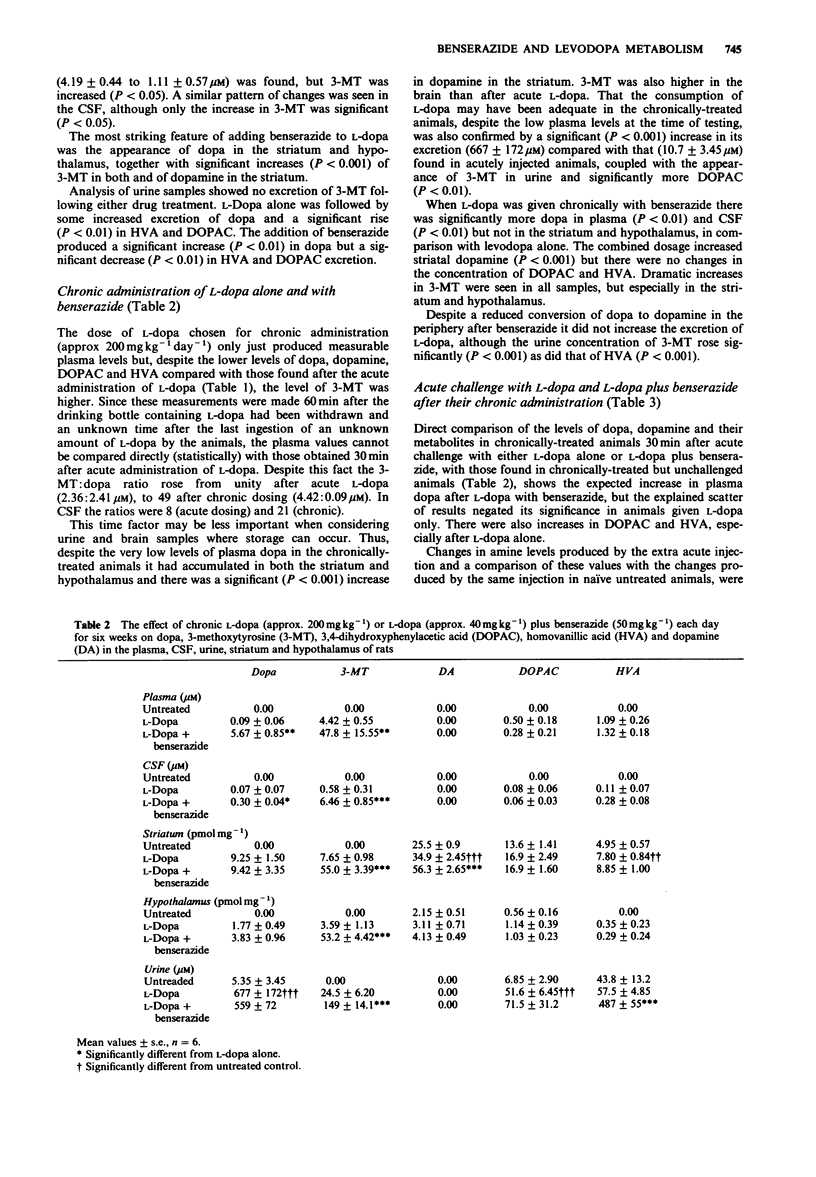
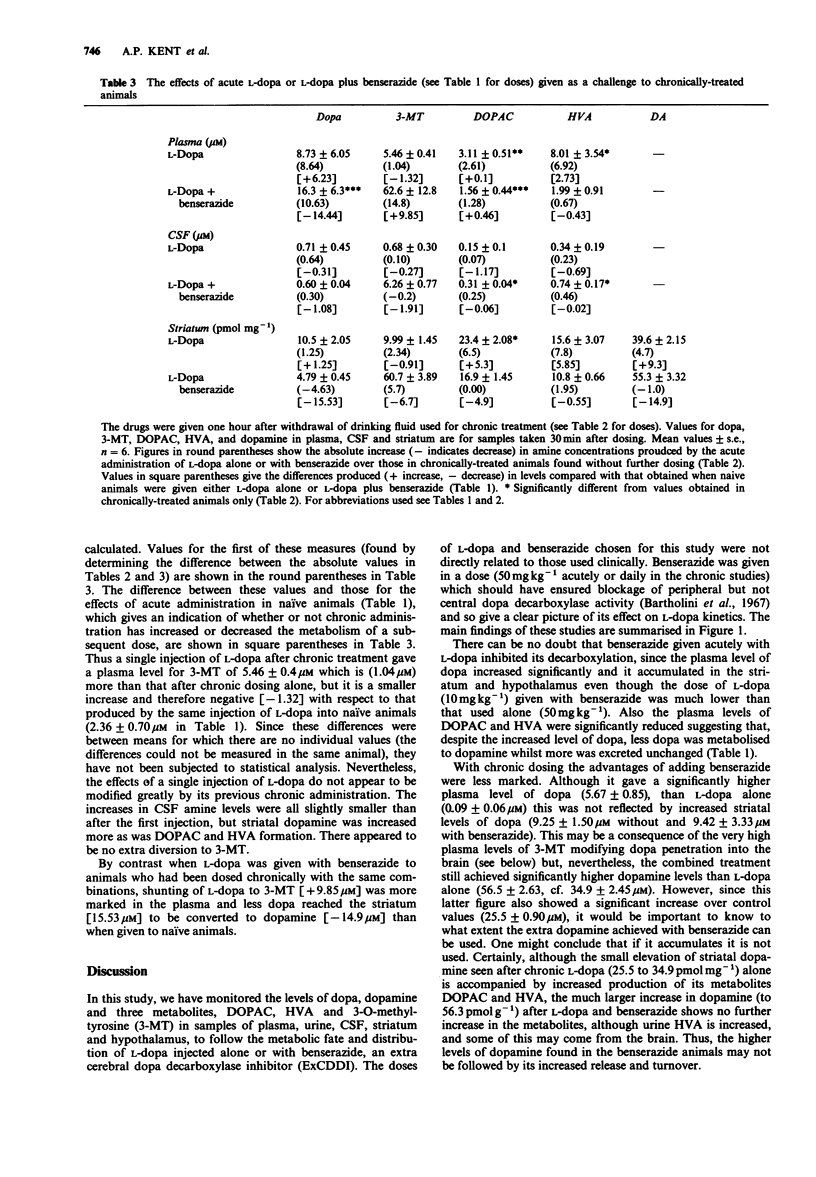
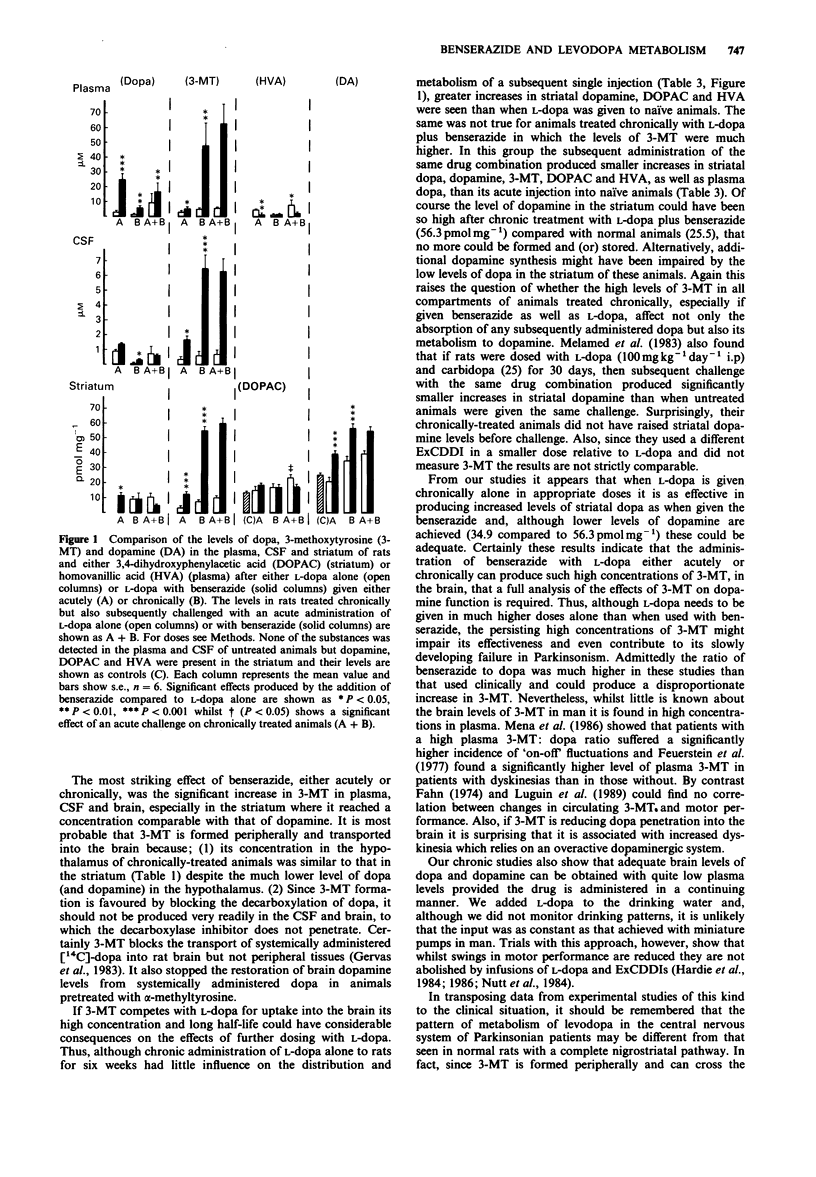
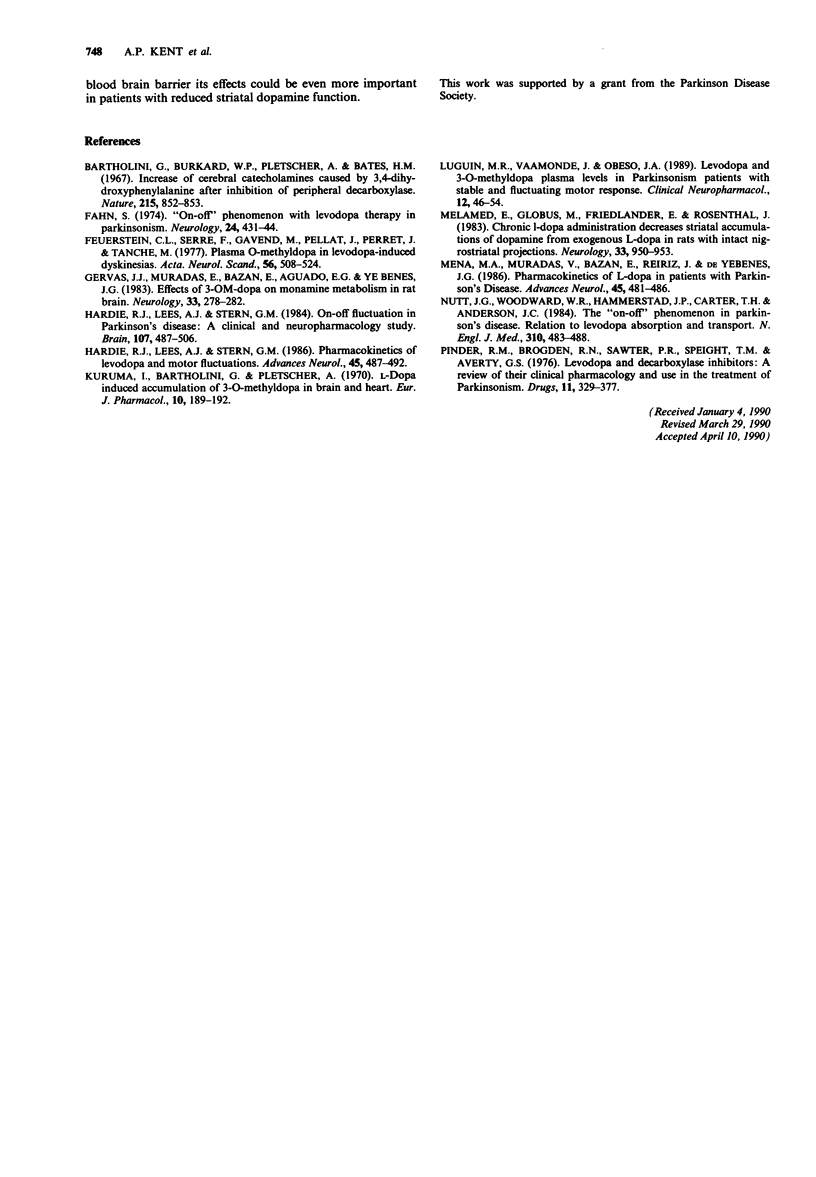
Selected References
These references are in PubMed. This may not be the complete list of references from this article.
- Bartholini G., Burkard W. P., Pletscher A. Increase of cerebral catecholamines caused by 3,4-dihydroxyphenylalanine after inhibition of peripheral decarboxylase. Nature. 1967 Aug 19;215(5103):852–853. doi: 10.1038/215852b0. [DOI] [PubMed] [Google Scholar]
- Fahn S. "On-off" phenomenon with levodopa therapy in Parkinsonism. Clinical and pharmacologic correlations and the effect of intramuscular pyridoxine. Neurology. 1974 May;24(5):431–441. doi: 10.1212/wnl.24.5.431. [DOI] [PubMed] [Google Scholar]
- Feuerstein C., Serre F., Gavend M., Pellat J., Perret J., Tanche M. Plasma O-methyldopa in levodopa-induced dyskinesias. A bioclinical investigation. Acta Neurol Scand. 1977 Dec;56(6):508–524. doi: 10.1111/j.1600-0404.1977.tb01456.x. [DOI] [PubMed] [Google Scholar]
- Gervas J. J., Muradás V., Bazán E., Aguado E. G., de Yébenes J. G. Effects of 3-OM-dopa on monoamine metabolism in rat brain. Neurology. 1983 Mar;33(3):278–282. doi: 10.1212/wnl.33.3.278. [DOI] [PubMed] [Google Scholar]
- Hardie R. J., Lees A. J., Stern G. M. On-off fluctuations in Parkinson's disease. A clinical and neuropharmacological study. Brain. 1984 Jun;107(Pt 2):487–506. doi: 10.1093/brain/107.2.487. [DOI] [PubMed] [Google Scholar]
- Hardie R. J., Lees A. J., Stern G. M. Pharmacokinetics of levodopa and motor fluctuations. Adv Neurol. 1987;45:487–492. [PubMed] [Google Scholar]
- Kuruma I., Bartholini G., Pletscher A. L-dopa-induced accumulation of 3-O-metyldopa in brain and heart. Eur J Pharmacol. 1970 May;10(2):189–192. doi: 10.1016/0014-2999(70)90272-4. [DOI] [PubMed] [Google Scholar]
- Luquin M. R., Vaamonde J., Obeso J. A. Levodopa and 3-O-methyldopa plasma levels in parkinsonian patients with stable and fluctuating motor response. Clin Neuropharmacol. 1989 Feb;12(1):46–54. doi: 10.1097/00002826-198902000-00006. [DOI] [PubMed] [Google Scholar]
- Melamed E., Globus M., Friedlender E., Rosenthal J. Chronic L-dopa administration decreases striatal accumulation of dopamine from exogenous L-dopa in rats with intact nigrostriatal projections. Neurology. 1983 Jul;33(7):950–953. doi: 10.1212/wnl.33.7.950. [DOI] [PubMed] [Google Scholar]
- Mena M. A., Muradas V., Bazan E., Reiriz J., de Yebenes J. G. Pharmacokinetics of L-dopa in patients with Parkinson's disease. Adv Neurol. 1987;45:481–486. [PubMed] [Google Scholar]
- Nutt J. G., Woodward W. R., Hammerstad J. P., Carter J. H., Anderson J. L. The "on-off" phenomenon in Parkinson's disease. Relation to levodopa absorption and transport. N Engl J Med. 1984 Feb 23;310(8):483–488. doi: 10.1056/NEJM198402233100802. [DOI] [PubMed] [Google Scholar]
- Pinder R. M., Brogden R. N., Sawyer P. R., Speight T. M., Avery G. S. Levodopa and decarboxylase inhibitors: a review of their clinical pharmacology and use in the treatment of parkinsonism. Drugs. 1976;11(5):329–377. doi: 10.2165/00003495-197611050-00001. [DOI] [PubMed] [Google Scholar]


